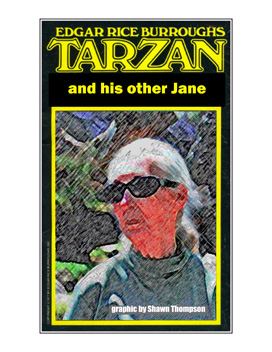
Commentary by Shawn Thompson, The Ethical Ape column on September 02, 2013. MongBay news.
The woman we know as Jane Goodall invites us to consider that she was created by Tarzan of the Apes.
We should take Jane Goodall seriously when she says that she was influenced by the fictional ape man and that as a child set on a path in life by him to go to Africa to work with wild animals.
And yet the influence Goodall finds in Tarzan likely goes deeper, anticipating the defiance of science and morality that allowed Goodall to become the remarkable scientist and a human being that she is. This connection also suggests a crucial, radical element of morality, that it depends ultimately on an act of the imagination.
What evidence is there for this?
In her 1999 “spiritual autobiography” Reason for Hope and in her public lectures, Goodall describes herself as a bookish child in love with nature, animals and the imagination.
By the time that Goodall was a child, the Tarzan mystique was well established. The first of the Tarzan novels created by the writer Edgar Rice Burroughs was Tarzan of the Apes published in 1912, twenty-two years before Goodall was born in 1934. By the time that Goodall started reading the novels as a girl of eleven in 1945, seventeen of the novels in the Tarzan series had been published.
Goodall explains in Reason For Hope that as a child she combined her love of nature, books and fiction by climbing up a beech tree at the family home where she could “feel a part of the life of the tree, swaying when the wind blew strongly, close to the rustling of the leaves… And I would read up there, in my own leafy and private world. I think I went through all the Tarzan books thirty feet or so above the ground. I was madly in love with the Lord of the Jungle, terribly jealous of his Jane. It was daydreaming about life in the forest with Tarzan that led to my determination to go to Africa, to live with animals and write books about them. I also went up Beech simply to be myself, to think.”
In her public lectures, Goodall repeats the references to Tarzan in her life frequently, saying, “I fell passionately in love with Tarzan — this glorious creature living out in the jungle doing all the things I wanted to do, and what did he do? He married the wrong Jane.”
In one interview, Goodall says that when her mother took her to see a Tarzan movie with Johnny Weissmuller as a child, she ran out of the theatre after ten minutes sobbing because the film violated her image of Tarzan from the novels. It was not how she “imagined” the reality of Tarzan and she hated the “wimpy” Jane who had her Tarzan as a lover. Goodall says she never saw another Tarzan film again in her life after this incident.
But the sustenance that Goodall found in the Tarzan novels may go even deeper.
In the Tarzan novels, Goodall would have found a more adult and intellectual version of brute beasts and the jungle than typical children’s books, with the greater legitimacy of being adult fiction and paradoxically a more compelling version of reality. After all, adult fiction needs to play by the rules of an adult sense of reality to get its credibility as fiction.
In the Tarzan novels, Goodall would have found an ape who defied science until science could catch up to that version of apes because of Jane Goodall. In creating his fictional apes, the writer Edgar Rice Burroughs, like Goodall later, indulged in the scientific and rational sin of anthropomorphizing the creatures, these “great man-like creatures” this “great anthropoid ape.”
Burroughs gives the apes individual names like human beings, not scientific objects, as Goodall will do later. The group is a “tribe,” part of “a species closely allied to the gorilla, yet more intelligent.” Kala, the female ape who will become Tarzan’s step mother and care for him, has a high forehead that shows “more intelligence” than the others. The apes communicate in sentences with each other. They give the human child the name “Tarzan,” which means “White-Skin” in their language.
The apes in the Tarzan novels have a rudimentary society and a rudimentary morality. The negotiate and have discussions as a group with such concepts as a sense of “inalienable rights.” They have shared moral principles which Burroughs calls unwritten “laws.”
The “mother love” of Kala for White Skin is “instinct” and she shows moral traits of being “unselfish” and “sacrificing” for her infant Tarzan. The apes “respect” each other. They create tools, such as large leaves functioning as blankets, demonstrating a capacity to create and use tools that it will take the scientist Jane Goodall decades to establish as a fact later.
The narrator of the Tarzan story even comments that the primitive rituals of the apes are the origin of “all the forms and ceremonials of modern church and state,” similar to a position that Goodall will take in what she sees as a ritualistic rain dance with chimpanzees when they approach a waterfall in the Kakombe valley. Goodall explains the rain dance and the limitations of chimpanzees in a passage near the end of Reason for Hope:
“But [chimpanzees] did not, during their evolution, develop the uniquely human ability to talk about that which is not present, share events of the distant past, plan for the far-off future, and, most important, discuss ideas, bouncing them back and forth to share the accumulated wisdom of an entire group. This spoken language would have enabled our ancestors to articulate feelings of awe, feelings that would lead to religious belief, then to organized worship. The chimpanzees, I believe, know feelings akin to awe [when they approach a waterfall in the Kakombe valley] .. a spiritual one. And sometimes, as they approach [the waterfall], the chimpanzees display in slow, rhythmic motion along the river bed… For ten minutes or more they may perform this magnificent ‘dance.’…Was it perhaps similar feelings of awe that gave rise to the first animistic religions, the worship of the elements and the mysteries of nature over which there was no control?… Spoken language would also have enabled our stone-age ancestors to develop a shared moral code of behavior. Chimpanzees show behaviors that seem likely precursors to human morality – as when a high-ranking individual breaks up a fight to save a weaker companion – but for the most part, in their society, ‘might’ is ‘right,’ and the subordinates have to be submissive whether or not they are in the wrong.” (Reason For Hope, pp. 188-189)
The scientific sins of Jane Goodall which led to her breakthroughs in science and morality involve imagination, which she can present more innocuously in Reason for Hope under the guise of exploring her childhood biographically.
Why do science and morality need imagination?
In order to understand chimpanzees, Goodall had to empathize with them, the same way we do with our fellow human beings to understand them.
In sympathy, or empathy, we feel what we think someone else is feeling. We feel their joy or pain in circumstances we don’t experience. Whether we feel what the other is feeling through some biological mechanism or through a total act of imagination, we are feeling in someone else what did not happen to us and what we can’t actually know.
Sympathy in turn prepares us for morality, to act unselfishly for the benefit of someone else.
The radical secret of the bookish yet adventurous girlhood of Jane Goodall is that science and morality depend on imagination, exactly the truth that science and morality have tried to hide and defend themselves against because it violates the rationalist tradition.
The fiction of Tarzan helped establish in the imagination of Jane Goodall the strength and the insight to see apes in a way that could eventually help to extend human morality.
In a sense, Jane Goodall was created by the fiction of the life of Tarzan and the result is that we have a better, more authentic Tarzan, a new and revised Man of the Apes who is partly the creation of his child Jane Goodall.






